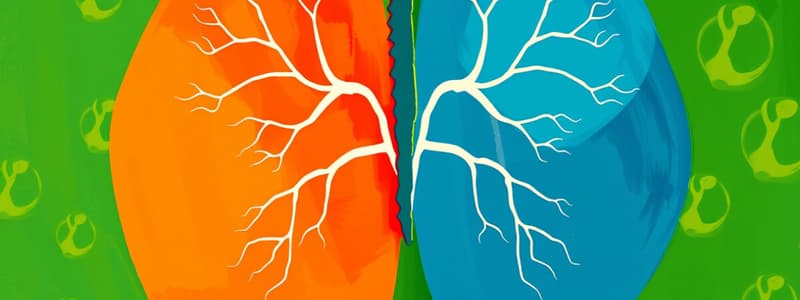Podcast
Questions and Answers
What hormone is responsible for moving glucose from blood into cells?
What hormone is responsible for moving glucose from blood into cells?
- Insulin (correct)
- Cortisol
- Adrenaline
- Glucagon
Which type of diabetes is characterized by an inability to produce insulin?
Which type of diabetes is characterized by an inability to produce insulin?
- Type II
- Gestational
- Latent autoimmune diabetes in adults (LADA)
- Type I (correct)
What is the primary cause of Type II diabetes?
What is the primary cause of Type II diabetes?
- Lack of physical exercise
- Obesity (correct)
- Stress
- Genetic mutations
Which hormone is produced by the testes?
Which hormone is produced by the testes?
What is one of the main functions of estrogen?
What is one of the main functions of estrogen?
What is a primary function of the endocrine system?
What is a primary function of the endocrine system?
Which system is known for faster responses: the nervous system or the endocrine system?
Which system is known for faster responses: the nervous system or the endocrine system?
What defines a target cell for a specific hormone?
What defines a target cell for a specific hormone?
Which of the following hormones is released by the pancreas to lower blood sugar?
Which of the following hormones is released by the pancreas to lower blood sugar?
Which type of gland releases hormones directly into the bloodstream?
Which type of gland releases hormones directly into the bloodstream?
What is the precursor lipid organic molecule for all steroid hormones?
What is the precursor lipid organic molecule for all steroid hormones?
Which class of hormones cannot enter the cells directly?
Which class of hormones cannot enter the cells directly?
How is hormone release primarily regulated in the body?
How is hormone release primarily regulated in the body?
What hormone is released when blood calcium levels fall too low?
What hormone is released when blood calcium levels fall too low?
Which hormone primarily stimulates the activity of osteoclasts in bones?
Which hormone primarily stimulates the activity of osteoclasts in bones?
Which gland secretes parathyroid hormone?
Which gland secretes parathyroid hormone?
What type of feedback mechanism regulates blood calcium levels?
What type of feedback mechanism regulates blood calcium levels?
Which group of hormones does the adrenal cortex primarily produce?
Which group of hormones does the adrenal cortex primarily produce?
What category of hormones is released from the zona glomerulosa of the adrenal cortex?
What category of hormones is released from the zona glomerulosa of the adrenal cortex?
Which hormones are released by the adrenal medulla?
Which hormones are released by the adrenal medulla?
Which hormone is released from the adrenal cortex in response to stress?
Which hormone is released from the adrenal cortex in response to stress?
Which of the following is a target tissue of growth hormone?
Which of the following is a target tissue of growth hormone?
What hormone from the hypothalamus inhibits growth hormone release?
What hormone from the hypothalamus inhibits growth hormone release?
During which stage of human lifespan is growth hormone secretion the highest?
During which stage of human lifespan is growth hormone secretion the highest?
What condition results from too much growth hormone prior to puberty?
What condition results from too much growth hormone prior to puberty?
What is the primary function of adrenocorticotrophic hormone (ACTH)?
What is the primary function of adrenocorticotrophic hormone (ACTH)?
Which hormone is released from the gonads in response to luteinizing hormone (LH) in males?
Which hormone is released from the gonads in response to luteinizing hormone (LH) in males?
What hypothalamic hormone stimulates the release of follicle stimulating hormone (FSH) from the pituitary?
What hypothalamic hormone stimulates the release of follicle stimulating hormone (FSH) from the pituitary?
What is the target organ of thyroid stimulating hormone (TSH)?
What is the target organ of thyroid stimulating hormone (TSH)?
Under which type of situation are hormones released from the adrenal medulla?
Under which type of situation are hormones released from the adrenal medulla?
What type of hormones are released by the adrenal medulla?
What type of hormones are released by the adrenal medulla?
Which of the following is NOT a cause of Cushing's syndrome?
Which of the following is NOT a cause of Cushing's syndrome?
During long-term stress situations, which part of the adrenal gland is activated?
During long-term stress situations, which part of the adrenal gland is activated?
What hormone is predominantly released by the pineal gland?
What hormone is predominantly released by the pineal gland?
Which statement about the pancreas is true?
Which statement about the pancreas is true?
What is the primary function of insulin?
What is the primary function of insulin?
In type I diabetes, which cells of the pancreas are primarily damaged?
In type I diabetes, which cells of the pancreas are primarily damaged?
Study Notes
Endocrine System Overview
- Functions include reproduction, growth, homeostasis, and emergency response.
- Hormones are chemical signals secreted into the extracellular fluid by endocrine cells.
Comparison: Nervous and Endocrine Systems
- Nervous system utilizes electrical signals, operating faster than endocrine signals.
- Endocrine responses last longer due to slower hormone breakdown.
Hormones and Gland Types
- Endocrine glands release hormones directly into the bloodstream; exocrine glands have ducts and release substances locally.
Major Endocrine Organs
- Involves glands such as the thyroid, adrenal, pancreas, ovaries, and testes, each with specific locations in the body.
Chemical Classes of Hormones
- Two classes: amino acid (e.g., epinephrine) and steroid hormones (e.g., estrogen, testosterone).
- Amino acid hormones use G protein and second messenger pathways, while steroid hormones can cross cell membranes.
Target Cells and Hormone Regulation
- Target cells possess specific receptors for hormones.
- Hormone release is regulated by negative feedback mechanisms, exemplified by insulin regulating blood sugar levels.
Growth Hormone and Related Hormones
- Stimulates connective tissues, muscles, and bones.
- Release controlled by Growth Hormone-Releasing Hormone (GHRH) and inhibited by Growth Hormone-Inhibiting Hormone (GHIH).
- Abnormal levels can lead to conditions such as giantism, dwarfism, or acromegaly.
Thyroid Function
- Thyroid Stimulating Hormone (TSH) stimulates T3 and T4 release; controlled by Thyroid Releasing Hormone (TRH).
Adrenocorticotropic Hormone (ACTH)
- Stimulates adrenal cortex hormone release; regulated by Corticotropic Releasing Hormone (CRH).
Gonad Hormones
- Follicle Stimulating Hormone (FSH) and Luteinizing Hormone (LH) regulate gamete and sex hormone release; controlled by Gonadotropic Releasing Hormone (GnRH).
Parathyroid Hormone (PTH) and Calcitonin
- PTH increases blood calcium levels, while calcitonin decreases them; both hormones target bone, kidney, and digestive tract.
Adrenal Gland Structure and Hormones
- Composed of an outer cortex (releases aldosterone and cortisol) and an inner medulla (releases epinephrine and norepinephrine).
- Corticosteroid hormones are vital for stress response.
Cushing's Syndrome
- Caused by pituitary tumors or steroid overdose; characterized by high blood glucose, muscle loss, and increased body fat.
Stress Response
- Short-term stress activates the adrenal medulla, releasing epinephrine; long-term stress activates the adrenal cortex, releasing cortisol.
Pineal Gland
- Located in the brain; releases melatonin, regulating sleep cycles.
Pancreatic Hormones
- Islets of Langerhans secrete insulin (lowers blood sugar) and glucagon (raises blood sugar); vital for glucose homeostasis.
Diabetes Mellitus
- Type I is characterized by an inability to produce insulin due to autoimmune destruction of beta cells.
- Type II, often caused by obesity, involves insulin resistance with adequate insulin production but ineffective glucose transport.
Testes and Ovaries Hormones
- Testes produce testosterone for male characteristics, while ovaries produce estrogen and progesterone for female reproductive functions, including menstrual cycle regulation and secondary sex characteristics.
Studying That Suits You
Use AI to generate personalized quizzes and flashcards to suit your learning preferences.
Description
Explore the functions and comparisons of the endocrine system outlined in Chapter 16. This study guide covers vital topics like reproduction, growth, homeostasis, and the differences between nervous and endocrine signals in terms of speed and duration. Test your understanding of how these systems interact and function.




